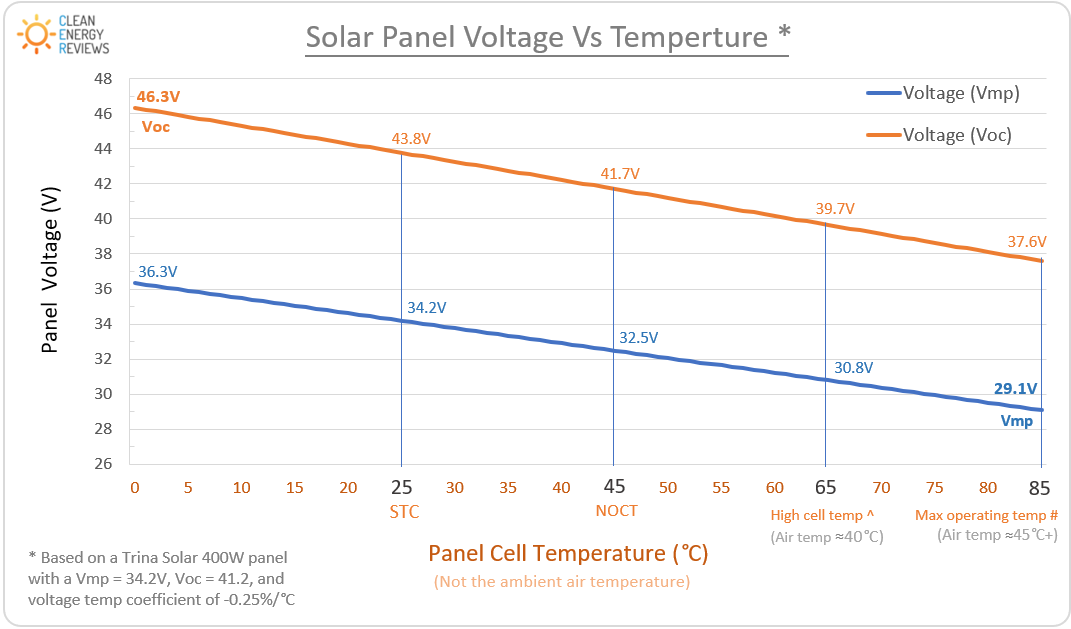
Solar String Voltage Calculator
Why is calculating the string voltage so important?
When designing a solar system using string solar inverters or solar charge controllers, accurately calculating the string voltage is critical to the system's reliability and safety. Solar systems must operate under a wide variety of extreme weather conditions and climates, and the operating temperature significantly affects the string voltage, which in turn impacts the system's performance. If the string voltage goes above or below the operating voltage of the inverter, MPPT or other associated equipment, it will severely reduce performance or, in a worst-case scenario, destroy the inverter or even cause a fire.
String Voltage Calculator Tool
1. Select your solar panel
2. Define the temperature range
Enter the known minimum and maximum temperatures recorded at the solar location. If you're in the US, you can use the UCF Solar Reference Map. If you're in Australia, you can use the BOM data records.
3. Number of panels in the string
Voc - Open Circuit Voltage explained
Calculating the maximum open circuit voltage (Voc) is one of the most critical factors when designing a solar system. All solar panels have an open circuit voltage measured under standard test conditions (STC) based on a cell temperature of 25°C, solar irradiance of 1000W/m2 and Air Mass of 1.5. However, in a real-world environment, the cell temperature will often be much lower or higher, which in turn increases or reduces the Voc. The amount of voltage (Voc) change is calculated based on the ambient temperature and the solar panel's "Temperature coefficient of Voc", which is the voltage difference for every degree in temperature change. The temperature coefficient of Voc is listed on the panel specification datasheet, along with the temperature power coefficient.
 Example solar module voltage vs temperature graph (Trina Solar Vertex
400W panel)
Example solar module voltage vs temperature graph (Trina Solar Vertex
400W panel)
Important: The solar panel voltage at STC and temperature coefficients are listed on the manufacturer's data sheet, refer to the example below. When using this tool, the STC data for your selected panel should be checked against the manufacturer's data sheet, which is also shown on the label on the rear side of the solar panel.
 Example panel data sheet
Example panel data sheet
Inverter MPPT operating voltage range
All modern string solar inverters have one or more MPPTs (maximum power point trackers) to track the string voltage and lock onto the optimum voltage, which in turn produces the maximum power. Throughout the day, many variables will influence the string voltage, including; weather, shading and temperature. As the string voltages changes, the MPPT will continuously adjust and track the optimum string voltage.
The MPPT operating voltage range for most string inverters is between 80V and 600V, depending on the inverter make and model. The voltage range for Solar MPPT charge controllers is generally much lower and varies from 24V up to 250V. However, several high-voltage models are available which operate up to 600V. The inverter or MPPT data sheet will list the MPPT operating voltage range. Refer to the example below.
 Example inverter MPPT voltage range table
Example inverter MPPT voltage range table
Attention Solar Designers!
You can design a complete solar system using the string voltage calculator to match your selected solar inverter using our free advanced Photonik solar design software. This also enables you to accurately design the solar array using high-resolution imagery and create detailed solar proposals in just a few minutes.
